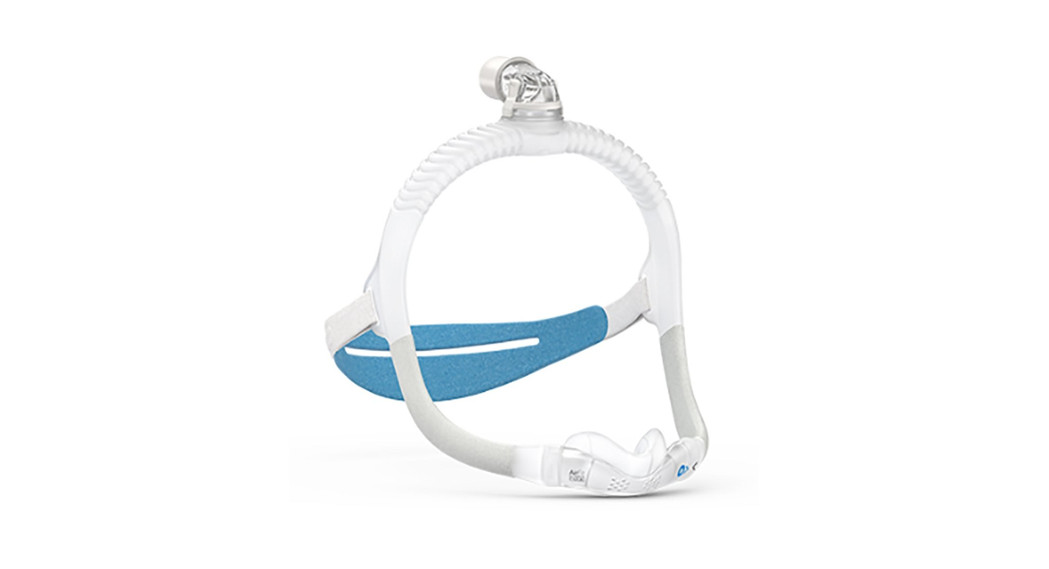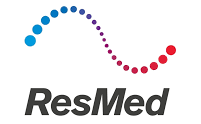
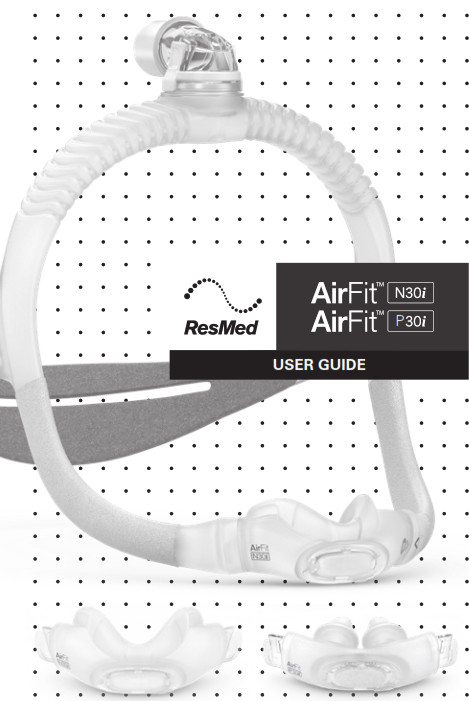
 USER GUIDE
USER GUIDE
|
Device SettingPillows |
QuietAir |
Nasal cardle mask |
Nasal pillows mask |
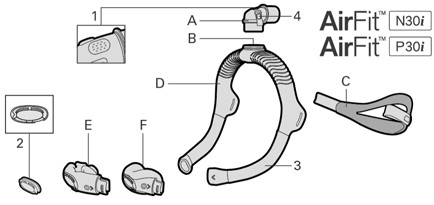
| A Elbow | 1. Vent |
| B Elbow ring | 2. QuietAir vent |
| C Headgear | 3. Sleeve |
| D Frame | 4. Side buttons |
| E P30i pillows cushion | |
| F N30i nasal cushion |
Intended useThe AirFit N30i and AirFit P30i masks are is intended to be used by patients weighing more than 30 kg who have been prescribed noninvasive positive airway pressure (PAP) therapy such as CPAP or bi-level therapy. The masks are intended for single patient re-use in the home and multi-patient re-use in the hospital/institutional environment.Please read the entire guide before use.
Before using your maskRemove all packaging and inspect each mask component for visible deterioration.Use the fitting template to assist in selecting the right size cushion and frame.
Fitting your mask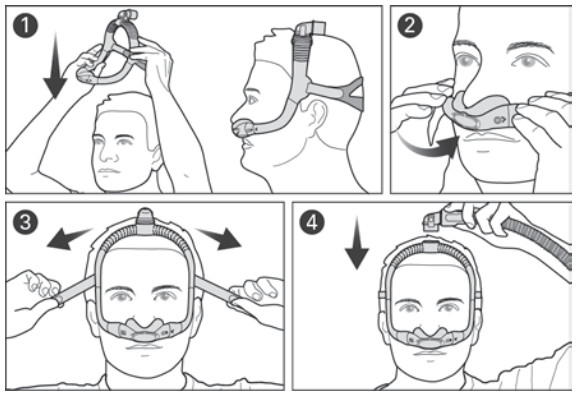
- Pull the frame and headgear over your head until the elbow is positioned on top and the headgear is behind your head.
- Place the cushion under your nose. For the AirFit P30i mask, align the pillows into your nostrils.
- Tighten or loosen the headgear until the cushion fits comfortably under your nose.
- Squeeze the side buttons on the elbow and detach from the frame. Connect the air tubing from your device to the elbow, then reattach to the frame.
Adjusting your mask
- When using the mask, air will flow out of the vents in the cushion and elbow. If air leaks from the side or top of the cushion, adjust the mask fitting to improve the seal.
- You can position the top of the frame forward or backwards over your head until the mask feels comfortable.
Sizing the mask frame If the mask frame falls back over your head or sits too close to your ears, try a small frame size. If the mask falls forward on your head or sits too close to your eyes, try a standard frame size.
If the mask frame falls back over your head or sits too close to your ears, try a small frame size. If the mask falls forward on your head or sits too close to your eyes, try a standard frame size.
Disassembling your mask for cleaningIf your mask is connected to a device, disconnect the device air tubing from the mask elbow.
- Pull the cushion from the frame.
- Undo the fastening tabs on the headgear strap and pull it from the frame.
- Squeeze the side buttons on the elbow and detach from the frame.Note: The QuietAir vent can be removed to allow inspection of the vent holes.
Cleaning your maskAfter each use: CushionWeekly: Headgear, frame and elbow
- Soak the components in warm water with a mild liquid detergent. Ensure that there are no air bubbles while soaking.
- Hand wash the components with a soft bristle brush. Pay particular attention to the vent holes.
- Thoroughly rinse the components under running water.
- For the frame sleeves, squeeze with a clean towel to remove excess water. Shake the QuietAir vent to remove any excess water. Leave the components to air dry out of direct sunlight. If the mask components are not visibly clean, repeat the cleaning steps.
Reassembling your mask
- Connect the elbow into the top of the frame until it clicks.
- Insert the headgear strap into the frame and fold the fastening tabs backwards.
- Insert the ends of the frame into the cushion, ensuring that the arrows on the cushion and frame are aligned.Note: If the elbow ring detaches, re-insert into the top of the frame.
Removing/inserting the QuietAir vent
- To remove the vent, gently pull the cushion away and slide the vent out.
- To insert the vent, align the tab (a) on the cushion with the notch (b) on the vent, and then gently pull the cushion over the vent.
![]() WARNING
WARNING
- The mask is not suitable for patients requiring life support ventilation.
- To avoid affecting the safety and quality of therapy, the mask vents must be kept clear to protect against rebreathing. Regularly inspect the vents to ensure they are kept clean, undamaged and clear of blockages.
- The mask must be used under qualified supervision for patients who are unable to remove the mask by themselves. The mask may not be suitable for those prone to aspiration.
- Regularly clean your mask to maintain the quality of your mask and to prevent the growth of germs that can adversely affect your health.
- Visual criteria for product inspection: If there is any visible deterioration of a mask component (cracking, crazing, tears etc.), the component should be discarded and replaced.
- Only use compatible CPAP or bi-level therapy devices. The technical specifications of the mask are provided for healthcare professionals to determine compatible devices. Use with incompatible devices may affect the performance or safety of the mask.
- Discontinue using the mask if you have ANY adverse reaction and consult your physician or sleep therapist.
- The mask is not intended to be used simultaneously with nebulizer medications that are in the air path of the mask/tube.
- Follow all precautions when using supplemental oxygen.
- Oxygen flow must be turned off when the CPAP or bilevel device is not operating, so that unused oxygen does not accumulate within the device enclosure and create a risk of fire.
- Oxygen supports combustion. Oxygen must not be used while smoking or in the presence of an open flame. Only use oxygen in well-ventilated rooms.
- At a fixed rate of supplemental oxygen flow, the inhaled oxygen concentration varies, depending on the pressure settings, patient breathing pattern, mask, point of application and leak rate. This warning applies to most types of CPAP or bilevel devices.
![]()
![]()
![]()
- Remove all packaging before using the mask.
- Using a mask may cause tooth, gum or jaw soreness or aggravate an existing dental condition. If symptoms occur, consult your physician or dentist.
- When fitting the mask, do not overtighten the headgear as this may lead to skin redness or sores around the mask cushion.
- The mask should not be used unless the device is turned on. Once the mask is fitted, ensure the device is blowing air to reduce risk of rebreathing exhaled air.
- As with all masks, some rebreathing may occur at low pressures.
- Always follow cleaning instructions and only use a mild liquid detergent. Some cleaning products may damage the mask, its parts and their function, or leave harmful residual vapours. Do not use a dish washer or washing machine to clean the mask.
- Do not iron the headgear as the material is heat sensitive and will be damaged.Note: For any serious incidents that occur in relation to this product, these should be reported to ResMed and the competent authority in your country.
Technical specifications
Compatible devicesFor a full list of compatible devices for this mask, see the Mask/Device Compatibility List at ResMed.com/downloads/masks. SmartStop may not operate effectively when using this mask with some CPAP or bi-level devices.
Pressure-flow curve: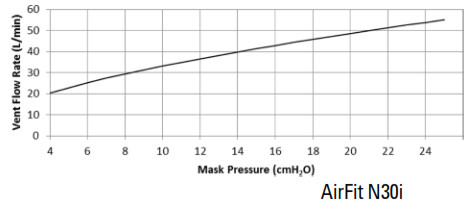

| Pressure (cm H2O) | Flow (L/min) |
| 4 | 20 |
| 9 | 31 |
| 15 | 41 |
| 20 | 49 |
| 25 | 55 |
| AirFit N30i | AirFit P30i | |
| Mask setting options: For AirSense, AirCurve or S9 | Pillows | Pillows |
| Therapy Pressure: | 4 to 25 cm H2O | 4 to 25 cm H2O |
| Resistance: Drop in pressure measured (nominal) | ||
| at 50 L/min | 0.5 cm H2O | 0.4 cm H2O |
| at 100 L/min | 1.7 cm H2O | 1.5 cm H2O |
| Sound: Declared dual-number noise emission values in accordance with ISO4871:1996 and ISO3744:2010. A-weighted sound power level and A-weighted sound pressure level at a distance of 1 m, with uncertainty of 3 dBA, are shown | ||
| Sound power level | 21 dBA | 21 dBA |
| Sound pressure level | 14 dBA | 14 dBA |
Environmental conditions:Operating temperature: 5°C to 40°COperating humidity: 15% to 95% non-condensingStorage and transport temperature: -20°C to +60°CStorage and transport humidity: up to 95% non-condensing
Service life: The service life of the mask system is dependent on the intensity of usage, maintenance, and environmental conditions to which the mask is used or stored. As this mask system and its components are modular in nature, it is recommended that the user maintain and inspect it on a regular basis, and replace the mask system or any components if deemed necessary or according to the `Visual criteria for product inspection’ in the `Warning’ section of this guide.Note: The manufacturer reserves the right to change these specifications without notice.
StorageEnsure that the mask is thoroughly clean and dry before storing it for any length of time. Store the mask in a dry place out of direct sunlight.
DisposalThis mask and packaging do not contain any hazardous substances and may be disposed of with your normal household refuse.
Reprocessing the mask between patientsThis mask should be reprocessed when used between patients. Cleaning, disinfection and sterilisation instructions are available on ResMed.com/downloads/masks. If you do not have internet access, please contact your ResMed representative.
SymbolsThe following symbols may appear on your product or packaging:
| Nasal cradle mask | Nasal pillows mask | ||
| QuietAir vent | Device setting – Pillows | ||
| Cushion size – small | Cushion size – medium | ||
| Cushion size – large | Cushion size – wide | ||
| Cushion size – small wide | Standard frame | ||
| Small frame | Importer | ||
| Medical device | Not made with natural rubber latex | ||
| Caution, consult accompanying documents. |
See symbols glossary at ResMed.com/symbols.
Consumer Warranty
ResMed acknowledges all consumer rights granted under the EU Directive 1999/44/EC and the respective national laws within the EU for products sold within the European Union.
References
[xyz-ips snippet=”download-snippet”]

